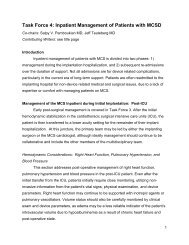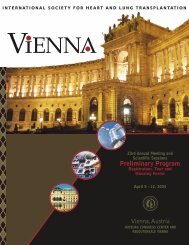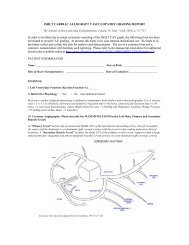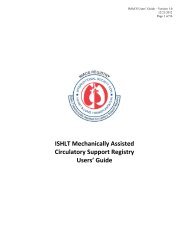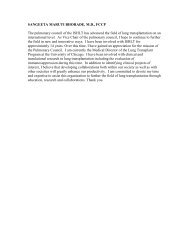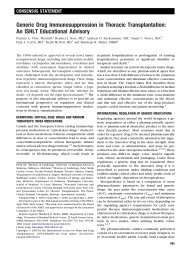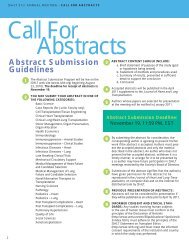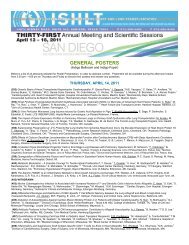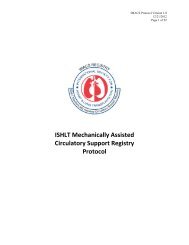Guidelines for the care of heart transplant recipients
Guidelines for the care of heart transplant recipients
Guidelines for the care of heart transplant recipients
You also want an ePaper? Increase the reach of your titles
YUMPU automatically turns print PDFs into web optimized ePapers that Google loves.
917<br />
Costanzo et al. <strong>Guidelines</strong> <strong>for</strong> Heart Transplant Care<br />
Adapted and reprinted with permission from Kirklin JK, et al. 46<br />
Table 1 Properties <strong>of</strong> Intravenous Vasoactive Drugs Used after Heart Transplantation<br />
Peripheral<br />
vasoconstriction<br />
Cardiac<br />
contractility<br />
Peripheral<br />
vasodilation<br />
Chronotropic<br />
effect<br />
Arrhythmia<br />
risk<br />
Isoproterenol 0 <br />
Dobutamine 0 <br />
Dopamine <br />
Epinephrine <br />
Milrinone/enoximone 0 <br />
Norepinephrine 0 <br />
Phenylephrine 0 0 0 0<br />
Vasopressin 0 0 0 0<br />
time are ideal, including donor young age, normal cardiac<br />
function, and absence <strong>of</strong> inotropic support.<br />
Class I:<br />
Level <strong>of</strong> Evidence: C.<br />
Topic 2: Early Post-operative Care <strong>of</strong> <strong>the</strong> Heart<br />
Transplant Recipient<br />
Recommendations on <strong>the</strong> Post-operative Monitoring <strong>of</strong> Class IIa:<br />
Heart Transplant Recipients: 13–31<br />
Class I:<br />
1. Peri-operative monitoring <strong>of</strong> <strong>heart</strong> <strong>transplant</strong> <strong>recipients</strong><br />
should include (1) continuous ECG monitoring; (2) postoperative<br />
12-lead ECG; (3) invasive arterial pressure<br />
monitoring; (4) direct measurement <strong>of</strong> right atrial pressure<br />
(RAP) or central venous pressure (CVP); (5) measurement<br />
<strong>of</strong> left atrial or pulmonary artery wedge pressure<br />
(PAWP); (6) intermittent measurement <strong>of</strong> cardiac<br />
output (CO); (7) continuous measurement <strong>of</strong> arterial<br />
oxygen saturation; (8) intraoperative transesophageal<br />
echocardiogram (TEE); (9) continuous assessment <strong>of</strong><br />
urinary output.<br />
Level <strong>of</strong> Evidence: C.<br />
Recommendations on <strong>the</strong> Management <strong>of</strong> Peri-operative<br />
Tricuspid Valve Regurgitation: 32,33<br />
Class I:<br />
1. Tricuspid valve regurgitation identified intraoperatively<br />
and estimated to be moderate or severe ( 2), should<br />
be re-evaluated by transthoracic echocardiogram (TTE)<br />
or TEE within 24 hours <strong>of</strong> HT and closely monitored <strong>for</strong><br />
<strong>the</strong> first few post-operative days. The frequency <strong>of</strong> subsequent<br />
follow-up should be guided by clinical and hemodynamic<br />
variables.<br />
Level <strong>of</strong> Evidence: C.<br />
Class II:<br />
1. DeVega annuloplasty <strong>of</strong> <strong>the</strong> donor tricuspid valve (TV)<br />
can be considered to maintain <strong>the</strong> normal size <strong>of</strong> <strong>the</strong> TV<br />
annulus.<br />
Level <strong>of</strong> Evidence: C.<br />
Recommendations on <strong>the</strong> Management <strong>of</strong> Peri-operative<br />
Pericardial Effusions: 34,35<br />
1. Pericardial effusions occurring after HT should be monitored<br />
by echocardiogram.<br />
2. Percutaneous or surgical drainage should be done when <strong>the</strong><br />
pericardial effusion causes hemodynamic compromise.<br />
Level <strong>of</strong> Evidence: C.<br />
1. Pericardial effusions that are not hemodynamically compromising<br />
do not require drainage unless <strong>the</strong>re is a strong<br />
suspicion <strong>of</strong> an infectious etiology.<br />
Level <strong>of</strong> Evidence: C.<br />
Recommendations <strong>for</strong> Peri-operative Vasoactive Drugs Use<br />
in Heart Transplant Recipients 36–46 :<br />
(See Table 1)<br />
Class I:<br />
1. Continuous infusion <strong>of</strong> an inotropic agent should be used<br />
to maintain hemodynamic stability post-operatively. Inotropic<br />
agents should be weaned as tolerated over <strong>the</strong> first<br />
3 to 5 days. The lowest effective dose should be used.<br />
Level <strong>of</strong> Evidence: C.<br />
2. The following <strong>the</strong>rapies are suggested:<br />
a. isoproterenol, 1 to 10 g/min, or<br />
b. dobutamine, 1 to 10 g/kg/min dopamine 1 to 10<br />
g/kg/min, or<br />
c. isoproterenol, 1 to 10 g/min dopamine 1 to 10<br />
g/kg/min, or<br />
d. milrinone, 0.375 to 0.75 g/kg/min<br />
Level <strong>of</strong> Evidence: C.<br />
3. Continuous infusion <strong>of</strong> -adrenergic agonists including<br />
phenylephrine, norepinephrine, or epinephrine can be<br />
used to maintain adequate mean arterial pressure.<br />
Level <strong>of</strong> Evidence: C.<br />
4. Low dose vasopressin (0.03–0.1 U/min) or methylene<br />
blue can be added to -agonist <strong>for</strong> vasodilatory shock.<br />
Level <strong>of</strong> Evidence: B.<br />
Recommendations <strong>for</strong> <strong>the</strong> Medical Management <strong>of</strong> Right<br />
Ventricular Dysfunction and Pulmonary Vascular Hypertension<br />
After Heart Transplantation 36–45,47 :<br />
(See Figure 1)



